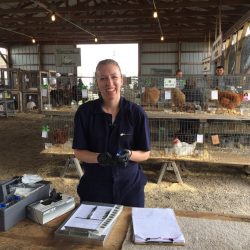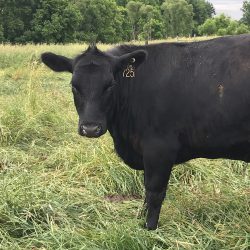By Stefany Gomez
This summer, as part of the Food Systems Fellowship, Stefany Gomez had the opportunity to work with MDARD, specifically in the Animal Industry Division, Cervid Department. Her main responsibilities included inputting test results for both CWD and TB tests and ensuring that the database contained the most up-to-date information regarding various herds’ inventory. In regard to CWD, Gomez was tasked with transferring this information into letters to be sent to producers to inform them about the quality of their samples. Because the laboratory will send back results indicating when a sample could not be tested, Gomez and her team provided the producers with this information and tips on how to turn out better samples. She produced similar letters for the veterinarians, as they are the ones tasked with physically collecting the samples. In addition to this, Gomez visited some Cervid farms with veterinarians to discuss their operations and to hear any concerns the producers had. She accompanied the DNR on one visit where they discussed fencing with a producer so as to keep the wild deer population away from their dairy cows.
Did you know that there are more than 55 species in the Cervidae (deer, elk, and moose) family? These species are found just about everywhere other than Antarctica, Australia, and sub-Saharan Africa. The two most common species that might pop into your head are your everyday Whitetail deer that you encounter on the roads and in your backyard and the Reindeer from Christmas stories. Depending on where you live in the United States, you might think automatically of moose and elk, which are two of the larger Cervidae.
The meat we harvest from these species is generally termed venison. Venison has a similar protein content to that of beef, but is lower in fat content. It can be produced as steaks, sausages, roasts, and jerky; for steaks, it is produced in specific cuts, much like beef. If you happen upon this meat at a supermarket, know that it was first inspected by the USDA. However, it is more likely that you will encounter venison at a restaurant or if you or someone you know hunts and harvests the meat.
In Michigan specifically, and in terms of Whitetail deer, we have a wild population as well as a captive population. We refer to the captive population as Privately Owned Cervids (POC). This term encompasses all captive Cervids, but here, I will be specifically referring to Whitetail due to the prevalence of our free-ranging population. POCs are provided medical services by local veterinarians as well as managed and regulated by the Michigan Department of Agriculture and Rural Development (MDARD). Local veterinarians provide everyday care, such as whole herd assessments, the administration of vaccines, and treatment of illnesses. MDARD regulates the animal’s health management and produces legislation in terms of which tests on the captive population are required in order to continue operations.
A permit to keep captive Cervids must be acquired from the Department of Natural Resources (DNR). DNR regulates the type of fencing and height of the fencing required to keep these deer (10 feet minimum) and requires farmers to keep detailed records of their inventory. In addition to this, the DNR regulates the wild Cervid population, in that they issue special hunting permits and run tests on samples collected by hunters.
Now, you may be wondering why this is important. Well, from live deer to venison on the table, your food is under surveillance. Both the wild population of deer, as well as the POCs, are constantly being tested for tuberculosis (TB) and chronic wasting disease (CWD). Tuberculosis is a zoonotic disease, meaning it can be transferred from animals to humans. Of particular concern is the fact that wild deer not only carry TB, but can transmit and receive TB to and from our cattle as well, which provides another source of possible contamination. On the other hand, while to date, CWD has not been shown to transmit to humans, the disease involves prions (infectious proteins); currently, research is underway to evaluate whether or not this disease has the potential to be transmitted to humans. But again, there is no evidence that suggests this to be the case.
As such, strict precautions are in measure and testing is constantly underway. Your local and state veterinarians individually test deer and cattle for TB and then return later to read the results. If a test produces suspect results, a sample is sent off to a laboratory, where further testing is conducted. To test for CWD, lymph node and brain stem samples are collected from the deer by your veterinarians and then sent to laboratories. Veterinarians spend hundreds of hours visiting farms with suspect deer, testing them or producing samples to be tested, treating them whenever possible, and ensuring their welfare, as well as ours. So, maybe the next time the opportunity presents itself, be adventurous and try some properly cooked venison—it may be your next favorite meat!



